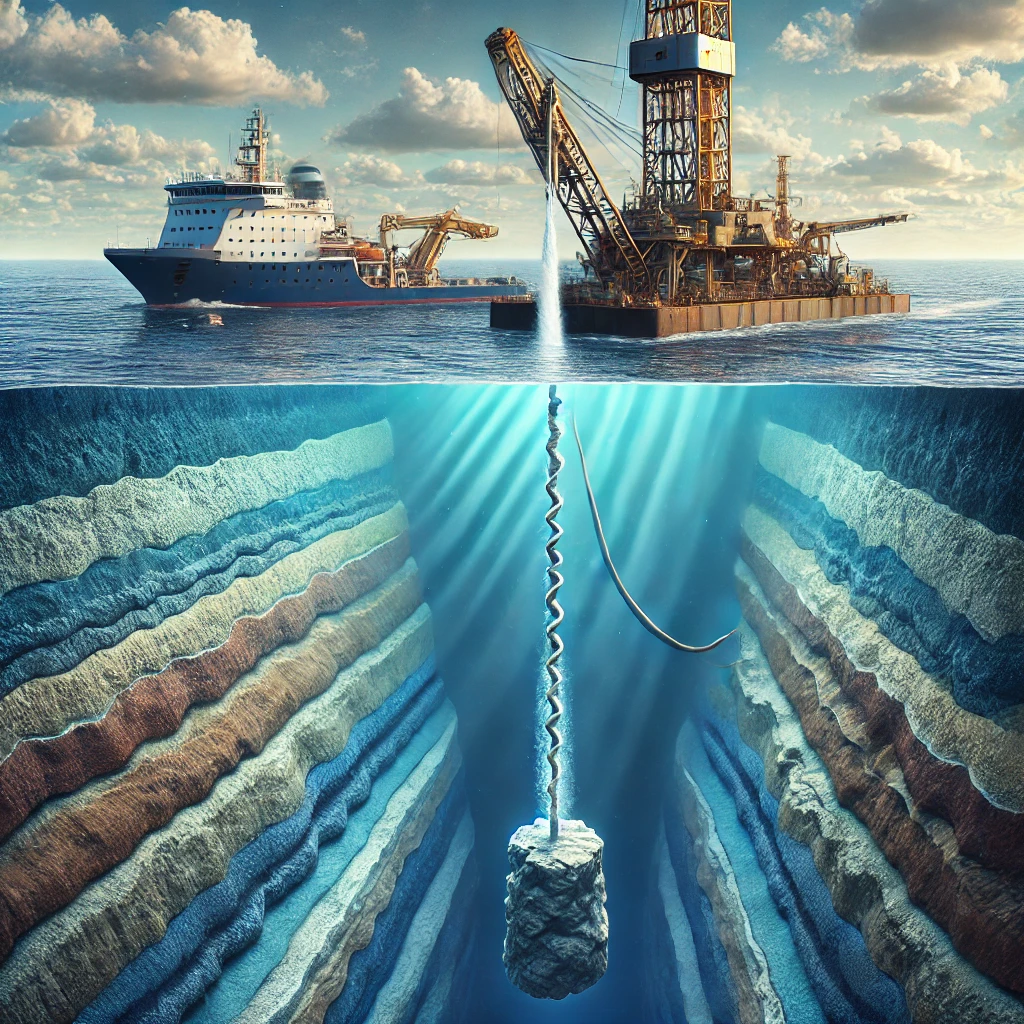
The Earth’s mantle, a colossal layer constituting over 80% of our planet’s volume, has long been a subject of fascination and mystery. In a monumental achievement, scientists aboard the US drilling vessel JOIDES Resolution have extracted the deepest rock sample ever obtained from the Earth’s mantle. By drilling approximately 1.2 kilometers beneath the seafloor at the Atlantis Massif, they have transcended previous depths of just 201 meters, marking a significant leap in geological exploration.
The Atlantis Massif: Gateway to the Mantle
- Location: The Atlantis Massif is an underwater mountain located near the Mid-Atlantic Ridge, a divergent tectonic plate boundary where seafloor spreading occurs.
- Geological Significance: This region is one of the few places on Earth where mantle rocks are accessible due to the movement of tectonic plates moving apart.
- Lost City Hydrothermal Field: The drilling site is near this hydrothermal field, known for its unique chimneys and ecosystems, providing valuable insights into deep-sea conditions.
Key Highlights of the Drilling Mission
- Programme:
- Conducted under the International Ocean Discovery Program (IODP), an international marine research collaboration.
- India is a funding partner, showcasing its commitment to global scientific endeavors.
- Sample Recovered:
- The new core sample is noteworthy for containing over 70% mantle rock, predominantly composed of silicate minerals.
- Technological Feat:
- Overcoming challenges of drilling at such depths under high pressure and low temperatures.
Significance of the Discovery
1. Understanding the Upper Mantle’s Composition
- Composition Analysis: Provides direct samples to study mineral composition, texture, and physical properties of the mantle.
- Geodynamic Insights: Helps in understanding mantle convection, plate tectonics, and the geological processes shaping Earth’s surface.
2. Chemical Reactions with Seawater
- Serpentinization Process:
- Interaction between mantle rocks and seawater leads to chemical reactions producing hydrogen and methane.
- This process alters the mineralogy of the rocks, creating serpentine minerals.
- Origin of Life Theories:
- Such hydrothermal reactions could have been crucial for abiogenesis—the origin of life on Earth—by providing essential chemical energy sources.
3. Potential for Extremophiles
- Heat-loving Bacteria:
- Deeper drilling allows the exploration of microbial life existing in extreme conditions.
- Studying these organisms can expand our understanding of the limits of life on Earth and potential life on other planets.
About the International Ocean Discovery Program (IODP)
- Mission:
- A global partnership aimed at exploring Earth’s history and dynamics through ocean basin exploration.
- Goals:
- Understand climate change, natural hazards, and the deep biosphere.
- Participants:
- Involves 23 nations, facilitating international scientific cooperation.
Relevance for India
1. Scientific Advancement
- Collaboration:
- Indian scientists have the opportunity to participate in cutting-edge research.
- Data Access:
- Direct access to valuable geological samples and data for research and education.
2. Strategic Interests
- Resource Exploration:
- Understanding mantle composition aids in mineral and energy resource exploration.
- Technological Development:
- Enhances expertise in deep-sea drilling and marine technology.
Implications for UPSC Exam Preparation
This discovery is significant for various segments of the UPSC syllabus:
General Studies Paper I – Geography
- Physical Geography:
- Structure and composition of the Earth’s interior.
- Plate tectonics and seafloor spreading mechanisms.
- Geomorphology:
- Formation of oceanic features like ridges and underwater mountains.
General Studies Paper III – Science and Technology
- Awareness in Science and Tech:
- Advances in deep-sea exploration technology.
- International collaborative research initiatives.
- Environment and Ecology:
- Study of extremophiles and their ecological significance.
- Understanding biogeochemical cycles.
General Studies Paper III – Environment
- Biodiversity:
- Discovery of new life forms in extreme environments.
- Climate Change and Origin of Life:
- Insights into how early life may have originated under extreme conditions.
Connecting the Dots
- Plate Tectonics and Mantle Dynamics:
- The movement of tectonic plates is driven by processes occurring in the mantle. This discovery provides tangible evidence to study these dynamics.
- Hydrothermal Vents and Life:
- The Lost City Hydrothermal Field is a prime location to study ecosystems that do not rely on sunlight, which is critical for understanding life in extreme environments.
- Astrobiology:
- Research on extremophiles contributes to the search for life on other planets, especially those with harsh environments similar to early Earth.
Additional Insights
Challenges of Deep-Sea Drilling
- Technical Difficulties:
- Maintaining drill stability in high-pressure underwater environments.
- Cost and Logistics:
- Deep-sea missions are expensive and require international funding and collaboration.
Future Prospects
- Deeper Exploration:
- Plans to drill deeper into the mantle to uncover more mysteries.
- Technological Innovation:
- Development of advanced materials and tools to withstand extreme conditions.
Did You Know?
- JOIDES Resolution:
- The name stands for Joint Oceanographic Institutions for Deep Earth Sampling Resolution, symbolizing the vessel’s mission to resolve questions about Earth’s structure.
- Mid-Atlantic Ridge:
- It is the longest mountain range in the world, though mostly underwater, and is a site where new ocean floor is created.
Enhance Your UPSC Preparation
To delve deeper into this topic, consider exploring:
- Plate Tectonics Theory:
- Understanding the movement of Earth’s lithospheric plates.
- Earth’s Interior Structure:
- Studying the crust, mantle, outer core, and inner core in detail.
- Marine Geology:
- The study of geological structures beneath the ocean floor.
Useful Resources:
- National Centre for Polar and Ocean Research (NCPOR)
- International Ocean Discovery Program (IODP) Official Website
- The Geological Society of India Publications
Conclusion
This groundbreaking achievement of obtaining the deepest rock sample from Earth’s mantle marks a significant step in geological sciences. It not only enhances our understanding of Earth’s interior and geological processes but also opens new avenues for research in origins of life and potential resources. For India, participation in such international collaborations underscores its growing role in global scientific research.
